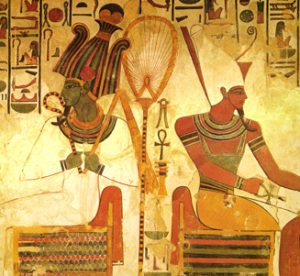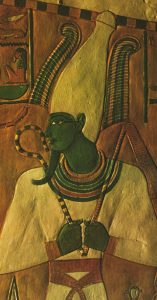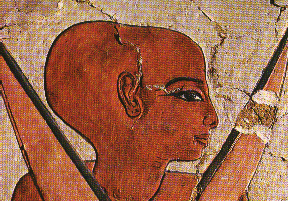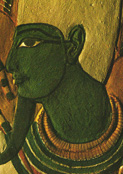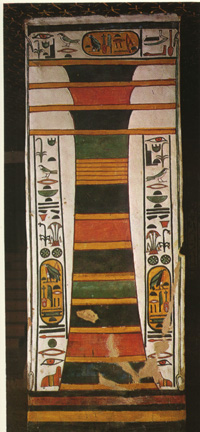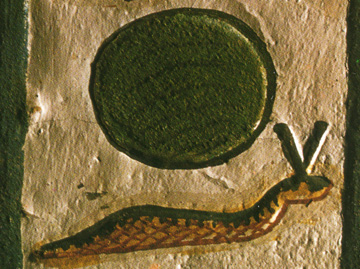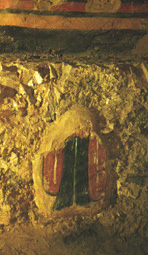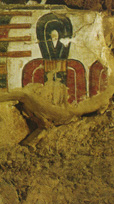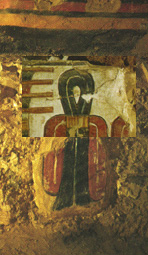Nefertari’s Tomb: First Chamber in the Descent
Al Fresco
Osiris
On Skin Color
Protection Symbols; Symbols of the Male and Female
Al Fresco
Done in the fresco technique, paint bonded to wet plaster laid over the rough limestone walls, the images in Nefertari’s tomb are over three thousand years old. The are battered–by natural decay, looters, earthquakes, human humidity and stupidity. Yet they stand. After three thousand years they still speak to viewers directly, easily, as if they haven’t aged a day—a paradox that makes sense, after all, since they are about eternity.
Osiris
To enter any tomb, including Nefertari’s, is to enter the realm of the Egyptian god Osiris. Osiris is the god of the underworld, of the dead, but he is also lord of all living human beings, since to the underworld they will go. Osiris’ spirit is ever-present in the images on the tomb’s walls, and he himself is frequently shown with his identifying symbols, especially the crook and flagellum and leopardskin-bag (he’s on the left below). Osiris’ posture is always regal and poised—in balance and repose whether sitting or standing. Here he wears white from shoulder to toe, setting off the deep and brilliant colors of his necklace and headdress. To the right of this image of Osiris, on an equally splendid throne and wearing an equally elaborate and colorful necklace, is Atum, “Lord of the Two Lands” of Upper and Lower Egypt, and also master of the Universe.
Below is another image of Osiris, wearing a different head-dress but in a similar pose. He looks dashing in white, no? To the right, another image, a close-up of a staff near Osiris. The reason why I include this is that coiled around this staff is the sinuous tendril of the papyrus plant, ending with its blossom (the 2 fan-shapes). This reedy plant, which grows near the Nile, proved central to Egyptian civilization, including building, craft-making, and writing (paper). Being associated with it does Osiris honor. To the left of the staff is a set of symbols, including the famous Egyptian ankh, symbol of life and breath, and a mini-papyrus glyph. Plus a snail—of which more later.
On Skin Color
Consider well the skin-tone colors of Osiris, Atum, and others on these walls. These images are enough to show that the Egyptians stressed the almost infinite variety of skin color; it was part of their claim to civilization. They thought of themselves as a crossroads and center of trade from the whole known world—Africa, Asia, the Mediterranean, and Europe. For this reason, all the world’s known skin colors were there, and are shown on these walls. Just as important: the deities who attend this civilization have as many skin colors as the people. Here are 3 different images, 4 different skin-tones:
Many of the decorative color-bands in the tomb paintings seem to play off this motif of celebrating the human color spectrum. The hues seem not rainbow hues but earth- , sand-, and skin-tones:
The support pillars, or djeds, in Nefertari’s tomb play with this color-variation motif as well; instead of creating borders, they stack bands of color upon color. In hieroglyphs, such pillars signify duration. They are the support pillars for the entire tomb ceiling: an array of colors creating strength and durability. The base is mud-like, like the swamps at the edge of the Nile that symbolized primordial beginnings. The pillars themselves create and uphold space for the human realm. Above the pillars in the tomb is a blue ceiling painted with stars. It’s not heaven underground, but a heaven discovered when the body is freed, at the end of Osiris’ spirit road.
Protection Symbols; Symbols of the Male and Female
Four major protection symbols repeatedly appear in the tomb paintings. Respectively, the symbolize protection, life, duration and fortune. [To right]
In some cases, as with the image to the right, these four glyphs are followed by an image of papyrus, the Nile reed plant whose plant fibers were pounded flat to make paper for writing.
When the papyrus glyph joins the others, it is translated as “all [his or her] guarding,” as if to suggest that the soul’s duration can be significantly protected or guarded by writing (or all the arts). The context seems to determine whether the gender reference is male or female.
Below, an photo of papyrus paper in close-up, emphasizing how it is made by layering the plant fiber:
In a few tomb paintings, there is a shell-less snail below the papyrus and protection glyphs. (It appears in the image to the right, for example.)
This combination appears to be painted only in connection with nearby male figures—Osiris or Ptah, for instance. This bare snail seems therefore to signify maleness; when the papyrus and snail glyphs are paired and follow the protection glyphs described above, they are translated by Hans Goedicke to mean “all his guarding” (52; my emphasis).
Look at how the snail below (from a different image) elongates himself as he travels. Where is he going?
Impossible not to admire the wit of this Egyptian snail-glyph for maleness! The snail without his protective shell is very vulnerable. His exposed body is soft and capable of many different shapes—elongated or contracted, erect or low. What a refreshingly different kind of phallus/male symbol this is. And to top it off (don’t make the phallus-sign too literal), he bears two highly sensitive antennae….
And women?
There are fascinating glyphs on the walls of Nefertari’s tomb associated with womanhood too. Especially notable are the “Isis-blood” figures; here are two fragments [not to scale]:
These Isis-images are often parts of a border-frieze, as shown here, and are associated with the djed-pillars signifying strength and duration, which are also common in border friezes in the tomb. Isis is the Egyptian goddess of fertility. The Isis-blood glyphs thus seem to signify both menstrual blood and, more broadly, women’s fertility and creative strength; without it, there would be no generations, no civilization, no on-going. Most are in fragments, as shown above. But look at the power the image gains when the fragments are reunited by the power of computer graphics:
The blood symbol coils its strength; it flows and abides. Its curvilinear motions make a powerful contrast to the stacked and angular abutments of the djed-symbols, which seem rather male-like (?). Both symbols signify strength and continuity, but different kinds, different understandings of its sources.
Both djed and blood glyphs celebrate color as well. The Isis-blood figure is dark red mixed with almost black, like menstrual blood’s varieties of color when it is fresh and when it has dried. And instead of being a mark of shame and pollution, the Isis-blood sign in Nefertari’s tomb is as important as the pillar in upholding the world.

